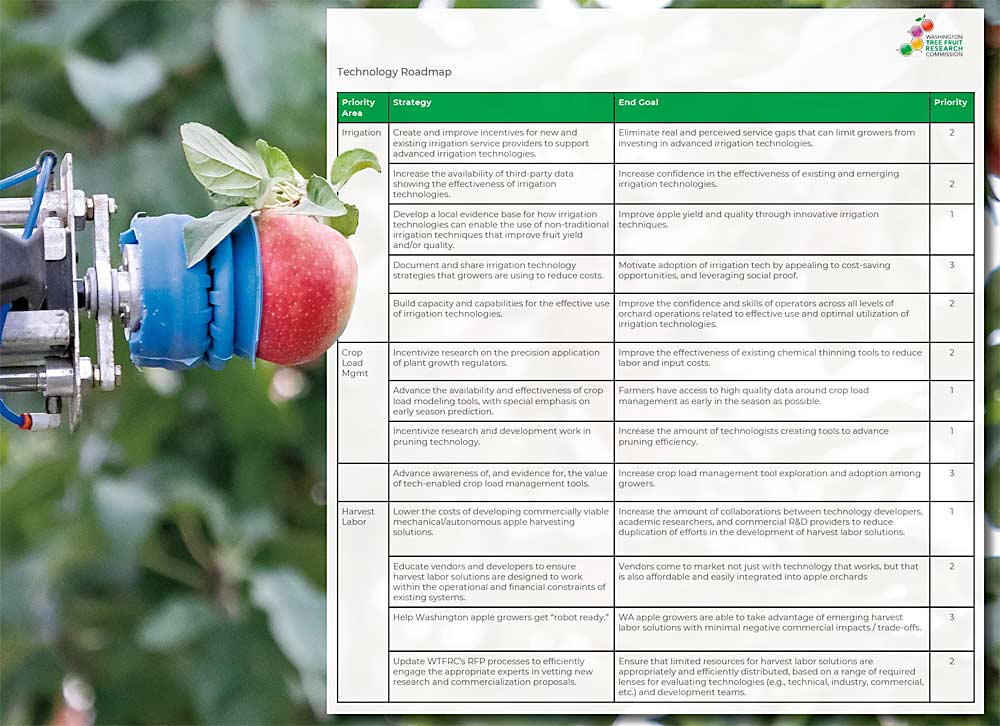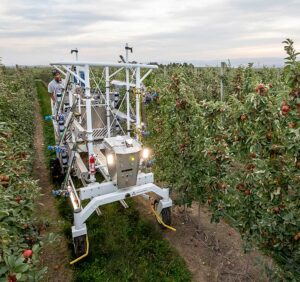
The Washington Tree Fruit Research Commission has released an updated Technology Roadmap, a document intended to crystalize priorities for technology research funding regarding apple technology over the next several years.
The 2024–26 roadmap, written with help from more than 100 people in the industry, intends to steer technology research funding in three priority areas: irrigation, crop load management and harvest labor.
Setting those priorities was one of the top goals, said Ines Hanrahan, executive director of the research commission.
“If I ask all of you what’s important right now, everybody will give me a list of 50 different things …,” she said at a dinner presentation in January in Wenatchee. “So, we (have to) try and prioritize things. Otherwise, you’re not going to go anywhere.”
Hanrahan and others also announced the new roadmap at the 2023 Technology Research Review in November and the Washington State Tree Fruit Association Annual Meeting in December. The research commission hired Australian company Tenacious Ventures, for $97,200, to put together the document.
WTFRC-Technology-Roadmap-2024-26For more information about the Technology Roadmap, visit the WTFRC website: treefruitresearch.org/about-us/technology-roadmap.
The roadmap casts each priority area over a different time frame, Hanrahan said: Irrigation is “near-term,” roughly two years. Crop load management is “mid-term,” meaning three to five years out. Harvest carries a five- to 10-year, “long-term” view.
Each one builds on the one before, Hanrahan said, asking the industry to avoid the trap of hyper focusing on robots to solve harvest labor problems. Of course, that’s important and exciting, she said, but improvements throughout the rest of the industry will help everyone — growers and tech companies — remain profitable.
“It’s a long game,” she said in a follow-up conversation with Good Fruit Grower.
Ultimately, navigating high labor costs is the puzzle, and robots are just one piece. “There are a lot of other things to be done to help the labor situation,” she said.
To do that, each priority area is broken into a series of strategies and end goals. For example, one of the irrigation strategies is to develop local evidence for the benefits of nontraditional techniques, with an end goal of using those techniques to improve yield and quality.
The top strategy for harvest labor funding? Lower the cost of mechanical and autonomous solutions. The end goal there is to increase collaboration between tech startups, researchers and research and development providers to reduce duplication.
Technology, and the idea of a roadmap, is rooted in research commission history.
One of the stated goals of the group, founded in 1969, was to usher in automation. The commission published its first tech roadmap in the early 2000s. Harvest platform adoption is a direct result, Hanrahan said.
That first roadmap also made its way to the U.S. Congress, helping convince lawmakers to bump up funding for specialty crop research, said Tory Schmidt, a program manager for the Washington Tree Fruit Research Commission. Creation of the Specialty Crop Research Initiative and nationwide genetic research project RosBREED are among the institutional efforts partially inspired by the roadmap.
“Not that it was a direct correlation, but certainly the focus of the tech roadmap helped lay the groundwork,” Schmidt said.
The roadmap also gives industry representatives confidence to ask better, more pointed questions of startups, such as whether the engineers really understand horticultural problems and if the companies have enough capital to make it across the finish line. Hanrahan wishes the industry had done so with earlier iterations of robotic harvesters.
The research commission contributed about $500,000 to Abundant Robotics to develop an automated vacuum harvester. After raising millions more in Silicon Valley venture capital and spending years on Washington field trials, the company declared bankruptcy in 2021.
The roadmap should give the industry more say in the direction of research, said Jon Cox, vice president of science and technology for Double Diamond Fruit in Quincy. Too often, he said, startups invent a tool, then look for a place to use it.
“It’s a hammer in search of a nail,” said Cox, a member of the research commission’s apple horticulture and postharvest committee.
Instead, folks inside the industry should be taking problems to engineers.
Matt Miles of Allan Bros. said the roadmap is a good communication tool for production companies to not only steer innovation but also help. For example, he thinks packing company quality control managers should evaluate fruit picked by harvest robot startups like advanced.farm and Tevel to make sure they stack up to industry metrics, freeing the engineers to focus on technical work.
“It’s not necessarily meant to be a control thing, although a portion of it is, but it’s meant to make sure that we’re keeping on track and to help deflect the areas that are not the primary goal,” said Miles, co-chair of the same committee.
—by Ross Courtney







Leave A Comment